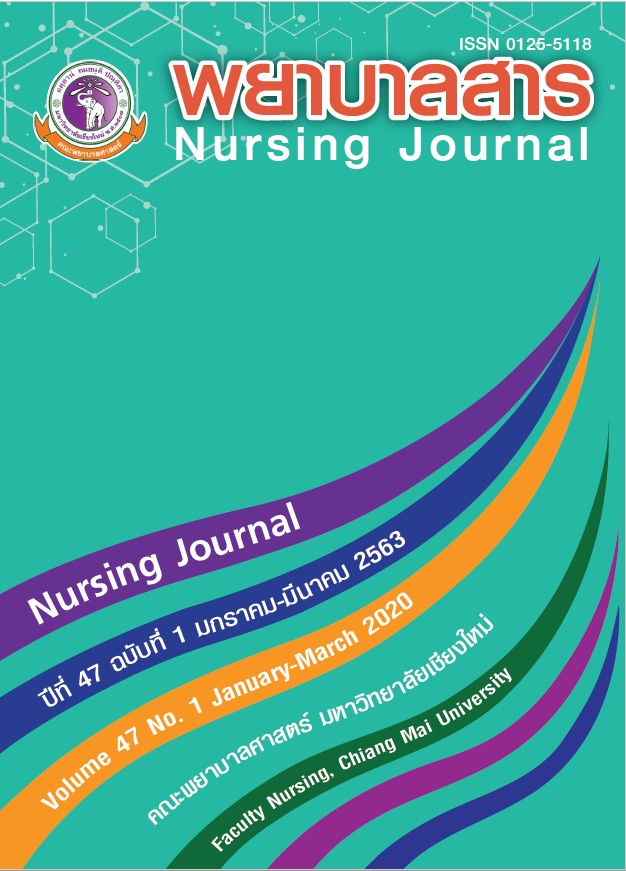Empowerment in Persons Undergone Coronary Artery Bypass Grafting: A Case Study
Keywords:
empowerment, perception of power, health behavior, coronary artery disease, coronary artery bypass graftAbstract
People who underwent coronary artery bypass grafting usually behave inappropriately after being discharged and this may lead to complications and the recurrence of the disease. Empowerment may help them to have appropriate health behaviors. The objectives of this intervention case study research were to study the process and outcomes of empowering people who underwent coronary artery bypass grafting. A purposive sampling of five persons with coronary artery disease who underwent coronary artery bypass graft surgery for two weeks. Health behaviors were promoted based on a conceptual framework of the Gibson’s empowerment process (Gibson, 1993), including four steps: 1) discovering reality, 2) reflecting critically, 3) taking charge, and 4) holding on. The research instruments consisted of the empowering process guidelines for persons who underwent coronary artery bypass grafting, the manual for persons with coronary artery disease, the manual for persons who underwent coronary artery bypass grafting, behaviors recording form for persons who underwent coronary artery bypass grafting, and audiotape. The instruments used for collecting data consisted of the demographic data record form, the health behaviors of persons who underwent CABG questionnaire, and the sense of power in persons who underwent CABG questionnaire. Data were analyzed by content analysis.
The results of the study revealed that:
- The process of empowerment composed of seven processes which are an establishment a good rapport, to use of questioning technique, individualized instruction, skills training through the demonstration and return demonstration, content review, admiring and encouraging, and continues caring.
- There are two outcomes from receiving empowerment
2.1 Perception of power: the participants had a greater sense of power than that of before.
2.2 Health behaviors: the participants practice better health behaviors than that of before.
The results from this study revealed that empowering persons who underwent coronary artery bypass grafting by utilizing 7 processes yielded positive outcomes. Therefore, encouraging nurses to gain knowledge and understanding of empowerment and be able to empower clients is crucial to support persons who underwent coronary artery bypass grafting to perform appropriate health behaviors, along with to enhance quality of nursing care.
References
Abu-Omar, Y., & Taggart, D. P. (2014). Coronary artery bypass surgery. Medicine, 42 (9), 527-531.doi:10.1016/j.mpmed.2014.06.008
Anderson, R. M., & Funnell, M. M. (2002). Using the empowerment approach to help patient change behavior. American Diabetes Association, 3-12.
Aree, P., Wijit, S., Wongsuraprakit, S., & Punyosophan, O. (2013). Effect of Eating Behaviors Modification Model on Serum Lipid and Blood Glucose Level in Women with Hyperlipidemia. Nursing Journal, 40 (supplement Jan), 14-22. (In Thai).
Gibson, C. H. (1993). A Study of empowerment in mothers of chronically ill children (Doctoral dissertation, Boston College, United States).
Janejob, P. (1999). Empowerment among Persons in Rheumatoid Arthritis (Master’s thesis, Chiangmai University). (In Thai).
Jantiya, M. (2004). Effect of Empowerment Program on Health Behaviors among Persons in Chronic Obstructive Pulmonary Disease (Master’s thesis, Chiangmai University). (In Thai).
Mahavarakorn, S. (2008). The Effect of Empowerment on Self-Care Behavior and Glycemic Control in Diabetes Type2 have Complications in Udonthani Hospital (Master’s thesis, Khon Kaen University). (In Thai).
Miller, A., & Miller, S. (2009). Coronary artery disease treatment guide. Heart & Vascular Institute. Retrieved from www.clevalandclinic.org/heart.
Noottaro, A. (2011). Angina in acute coronary syndrome patients. Royal Thai air force medical gazette, 57 (2), 13-88.
Ong, L. P., & Nair, S. K. (2015). Surgery for coronary artery disease. Surgery (Oxford), 33 (2), 78-85.doi:10.1016/j.mpsur.2014.12.006
On non, B. (2004). Effect of group empowerment on self-care agency among persons with diabetes mellitus (Independent study, Chiangmai University). (In Thai).
Public Health Statistics Strategy and Planning division Ministry of Public Health. (2019). Numbers and Rates of Ischemic Heart Disease per 100,000 population. Retrieved from http://social.nesdb.go.th/SocialStat/StatReport_Final.aspx?repo rtid=226& template=2R1C&yeartype=M&subcatid=17. (In Thai).
Sabik, J. F., Blackstone, E. H., Gillinov, A. M., Smedira, N. G., & Lytle, B. W. (2006). Occurrence and risk factors for reintervention after coronary artery bypas s grafting. Circulation,114(1 Suppl), 1454-1460. doi:10.1161/CIRCULATIONAHA.105.001149
Sanehwong, J. (2005). Family Support as Perceived by Patients and Adaptation Behavior in Patients undergone Coronary Artery Bypass Grafting (Master’s thesis, Khon Kaen University). (In Thai).
Sayasathid, J. (2012). common cardiac surgery. Phitsanulok: Global print. (In Thai).
Sithisuk, S. (2014). Guideline for the practice of care inpatients in ischemic heart disease, revised version 2014 (2nd ed.). Bangkok: Srimuang Printing. (In Thai).
Stone, J. R.. (2012). Pathology of myocardial infarction, coronary artery disease, plaque disruption, and the vulnerable atherosclerotic plaque. Diagnostic Histopathology, 18 (11),478-483. doi:10.1016/j.mpdhp.2012.09.001
The Society of Thoracic Surgeons of Thailand. (2015). Heart Surgery Statistics in Thailand.Retrieved from http://thaists.org/news_detail.php?news_id=212 ( In Thai).
Wichitthongchai, C. (2012). Effects of Nutritional Education in Patients After Coronary Artery Bypass Graft Surgery at Queen Sirikit Heart Center of the Northeast, Faculty of Medicine, Khon Kaen University (Master’s thesis, Khon Kaen University). (In Thai)
Yamsribua, T. (2009). Factors affecting self-care behaviors of coronary artery disease patients receiving coronary artery bypass graft at Phramongkutklao Hospital (Master’s thesis, Kasetsart University). (In Thai)
Downloads
Published
How to Cite
Issue
Section
License
บทความที่ได้รับการตีพิมพ์เป็นลิขสิทธิ์ของวารสารพยาบาลสาร
ข้อความที่ปรากฏในบทความแต่ละเรื่องในวารสารวิชาการเล่มนี้เป็นความคิดเห็นส่วนตัวของผู้เขียนแต่ละท่านไม่เกี่ยวข้องกับมหาวิทยาลัยเชียงใหม่ และคณาจารย์ท่านอื่นๆในมหาวิทยาลัยฯ แต่อย่างใด ความรับผิดชอบองค์ประกอบทั้งหมดของบทความแต่ละเรื่องเป็นของผู้เขียนแต่ละท่าน หากมีความผิดพลาดใด ๆ ผู้เขียนแต่ละท่านจะรับผิดชอบบทความของตนเองแต่ผู้เดียว






